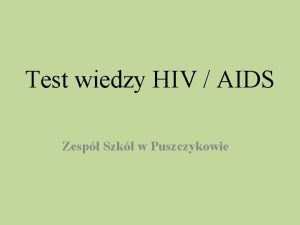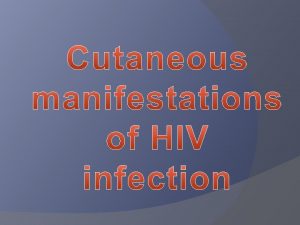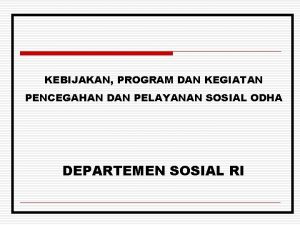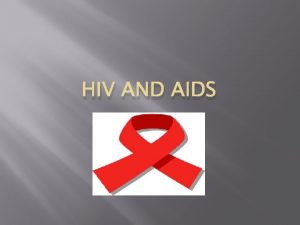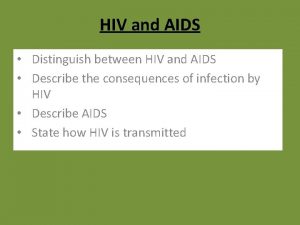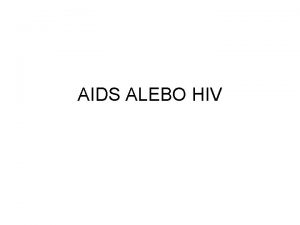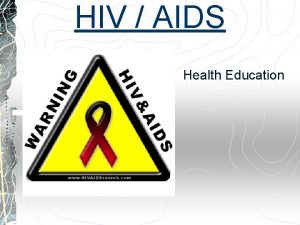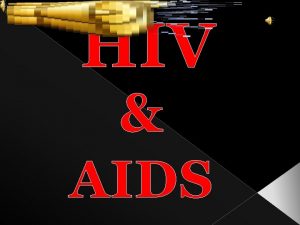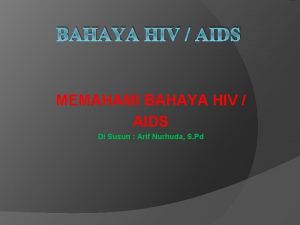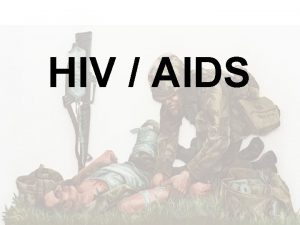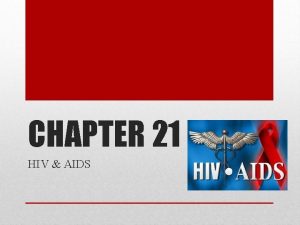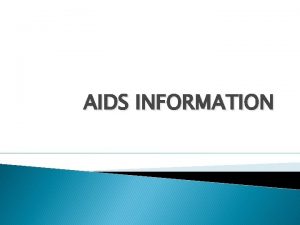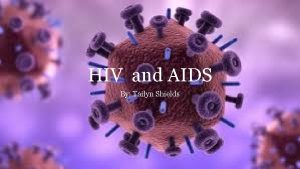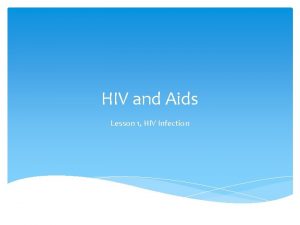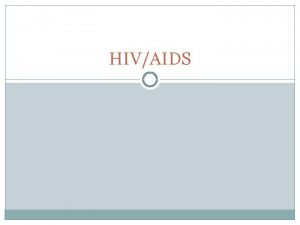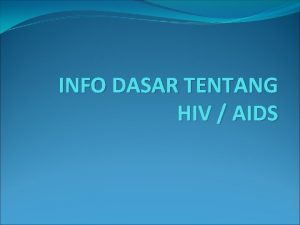HIV AND AIDS HIV STRUCTURE The HIV particle






















- Slides: 22

HIV AND AIDS

HIV STRUCTURE §The HIV particle is composed of a dense, single-strand RNA core surrounded by a lipoprotein envelope a retrovirus of the lentivirus family. § The. RNA contains reverse transcriptase, which allows the RNA to be transcribed into DNA, which is then integrated into the host's genome. §The cell then becomes an HIV-producing machine. § The receptor in the lipoprotein envelope that allows the HIV to attach to the CD 4+ T cell is named gpl 20 §. As opposed to influenza, the envelope on HIV is highly variable; therefore, it is much more difficult to make a vaccine against it.

HOW HIV INFECTS q. HIV gp 120 envelope glycoprotein binds to the CD 4 receptors and coreceptors (such as CCR 5) on the helper T cells, macrophages, and monocytes. The virus must bind to both the CD 4 and CCR 5 molecule to fuse with the cell. q After fusion, the viral core material enters the cell and is reverse transcribed into DNA that integrates into the human genome and codes for the production of more virion RNA and structural proteins. q. These proteins, after being cleaved by a protease, then combine with the viral RNA and bud off of the cell using the CD 4 cell membrane as a new envelope. q This eventually causes destruction of the CD 4 cells. The CD 4 cells are the major regulator cells in the body; they suppress B lymphocytes and regulate the CD 8 suppressor cells.

HOW HIV INFECTS q. With the decrease in CD 4+ counts, B cells become deregulated and are no longer suppressed, causing a polyclonal increase in total serum immunoglobulins, even though overall antibody function is decreased. q For this reason, infectious diseases in AIDS patients include not only the cell-mediated infections (PCP, viruses, mycobacteria, and fungi), but also those seen with humoral deficiency (pneumococcus, meningococcus, Giardia).

HIV IS TRANSMITTED: ● By sexual contact. ● By exposure to blood or blood products (e. g. drug users, patients with haemophilia or occupationally in healthcare workers). ● Vertically from mother to child in utero, during birth or by breastfeeding.

HIV IS TRANSMITTED:

DIAGNOSIS


DIAGNOSIS

DIAGNOSIS

THE DIFFERENTIAL DIAGNOSIS INCLUDES: ● Acute Epstein–Barr virus. ● Cytomegalovirus. ● Streptococcal pharyngitis. ● Toxoplasmosis. ● Secondary syphilis.

STAGES Following diagnosis, the CD 4 lymphocyte count should be determined. This indicates the degree of immune suppression and is used to guide treatment

NATURAL HISTORY AND CLASSIFICATION OF HIV PRIMARY INFECTION Primary infection is symptomatic in >50% of cases and usually occurs 2– 4 wks after exposure. The major clinical manifestations resemble infectious mononucleosis: ● Fever. ● Pharyngitis with lymphadenopathy. ● Myalgia/arthralgia. ● Headache. ● Diarrhoea. ● Mucosal ulceration. ● Oral and genital ulceration

ASYMPTOMATIC INFECTION : VIRAEMIA PEAKS DURING THIS PHASE AND HIGH VIRAL LOADS PREDICT A MORE RAPID RATE OF DECLINE IN CD 4 COUNT THE MEDIAN TIME FROM INFECTION TO DEVELOPMENT OF AIDS IN ADULTS IS 9 YRS.

AIDS IS DEFINED BY THE DEVELOPMENT OF SPECIFIED OPPORTUNISTIC INFECTIONS, TUMOURS AND OTHER CLINICAL FEATURES THIS IS ACCOMPANIED BY A FALL IN CD 4 COUNT TO <200, AND A CHANGE IN THE SPECTRUM OF ASSOCIATED INFECTIONS.







Thank you Done by : Adonia Hadad
 Chapter 25 sexually transmitted infections and hiv/aids
Chapter 25 sexually transmitted infections and hiv/aids Chapter 24 sexually transmitted diseases and hiv/aids
Chapter 24 sexually transmitted diseases and hiv/aids Test wiedzy o hiv i aids z odpowiedziami
Test wiedzy o hiv i aids z odpowiedziami Causative organism of hiv/aids
Causative organism of hiv/aids Recognize developmental disorders of the dentition
Recognize developmental disorders of the dentition Kasus hiv aids
Kasus hiv aids Hình ảnh bộ gõ cơ thể búng tay
Hình ảnh bộ gõ cơ thể búng tay Bổ thể
Bổ thể Tỉ lệ cơ thể trẻ em
Tỉ lệ cơ thể trẻ em Chó sói
Chó sói Chụp phim tư thế worms-breton
Chụp phim tư thế worms-breton Alleluia hat len nguoi oi
Alleluia hat len nguoi oi Môn thể thao bắt đầu bằng chữ đua
Môn thể thao bắt đầu bằng chữ đua Thế nào là hệ số cao nhất
Thế nào là hệ số cao nhất Các châu lục và đại dương trên thế giới
Các châu lục và đại dương trên thế giới Công thức tính độ biến thiên đông lượng
Công thức tính độ biến thiên đông lượng Trời xanh đây là của chúng ta thể thơ
Trời xanh đây là của chúng ta thể thơ Mật thư anh em như thể tay chân
Mật thư anh em như thể tay chân Làm thế nào để 102-1=99
Làm thế nào để 102-1=99 Phản ứng thế ankan
Phản ứng thế ankan Các châu lục và đại dương trên thế giới
Các châu lục và đại dương trên thế giới Thơ thất ngôn tứ tuyệt đường luật
Thơ thất ngôn tứ tuyệt đường luật


